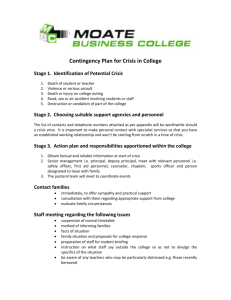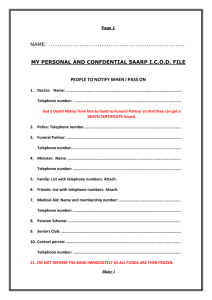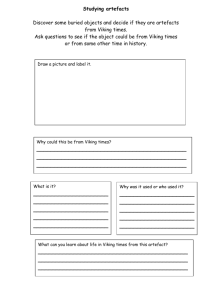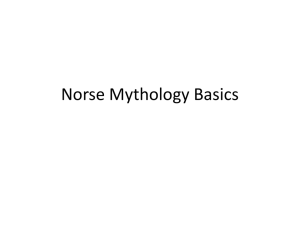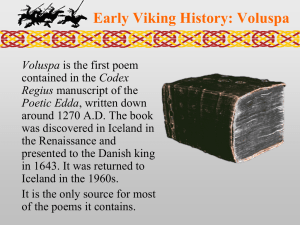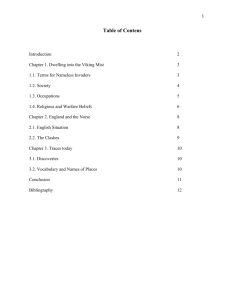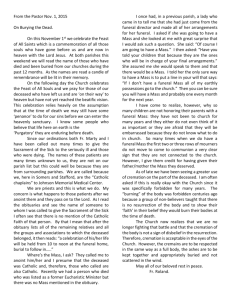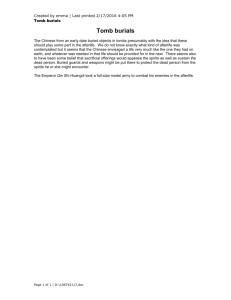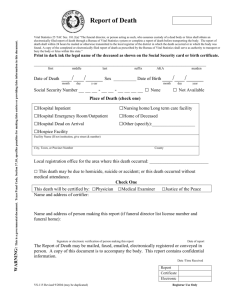Norse - cog.org
advertisement
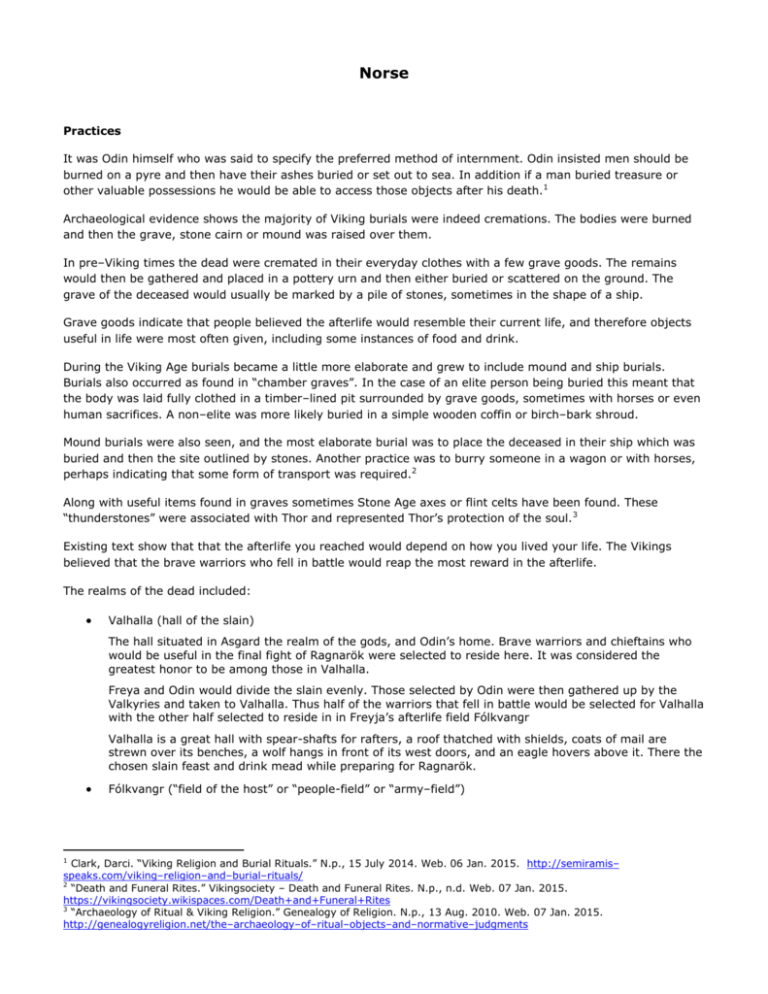
Norse Practices It was Odin himself who was said to specify the preferred method of internment. Odin insisted men should be burned on a pyre and then have their ashes buried or set out to sea. In addition if a man buried treasure or other valuable possessions he would be able to access those objects after his death.1 Archaeological evidence shows the majority of Viking burials were indeed cremations. The bodies were burned and then the grave, stone cairn or mound was raised over them. In pre–Viking times the dead were cremated in their everyday clothes with a few grave goods. The remains would then be gathered and placed in a pottery urn and then either buried or scattered on the ground. The grave of the deceased would usually be marked by a pile of stones, sometimes in the shape of a ship. Grave goods indicate that people believed the afterlife would resemble their current life, and therefore objects useful in life were most often given, including some instances of food and drink. During the Viking Age burials became a little more elaborate and grew to include mound and ship burials. Burials also occurred as found in “chamber graves”. In the case of an elite person being buried this meant that the body was laid fully clothed in a timber–lined pit surrounded by grave goods, sometimes with horses or even human sacrifices. A non–elite was more likely buried in a simple wooden coffin or birch–bark shroud. Mound burials were also seen, and the most elaborate burial was to place the deceased in their ship which was buried and then the site outlined by stones. Another practice was to burry someone in a wagon or with horses, perhaps indicating that some form of transport was required.2 Along with useful items found in graves sometimes Stone Age axes or flint celts have been found. These “thunderstones” were associated with Thor and represented Thor’s protection of the soul. 3 Existing text show that that the afterlife you reached would depend on how you lived your life. The Vikings believed that the brave warriors who fell in battle would reap the most reward in the afterlife. The realms of the dead included: Valhalla (hall of the slain) The hall situated in Asgard the realm of the gods, and Odin’s home. Brave warriors and chieftains who would be useful in the final fight of Ragnarök were selected to reside here. It was considered the greatest honor to be among those in Valhalla. Freya and Odin would divide the slain evenly. Those selected by Odin were then gathered up by the Valkyries and taken to Valhalla. Thus half of the warriors that fell in battle would be selected for Valhalla with the other half selected to reside in in Freyja’s afterlife field Fólkvangr Valhalla is a great hall with spear-shafts for rafters, a roof thatched with shields, coats of mail are strewn over its benches, a wolf hangs in front of its west doors, and an eagle hovers above it. There the chosen slain feast and drink mead while preparing for Ragnarök. 1 Fólkvangr (“field of the host” or “people-field” or “army–field”) Clark, Darci. “Viking Religion and Burial Rituals.” N.p., 15 July 2014. Web. 06 Jan. 2015. http://semiramis– speaks.com/viking–religion–and–burial–rituals/ 2 “Death and Funeral Rites.” Vikingsociety – Death and Funeral Rites. N.p., n.d. Web. 07 Jan. 2015. https://vikingsociety.wikispaces.com/Death+and+Funeral+Rites 3 “Archaeology of Ritual & Viking Religion.” Genealogy of Religion. N.p., 13 Aug. 2010. Web. 07 Jan. 2015. http://genealogyreligion.net/the–archaeology–of–ritual–objects–and–normative–judgments Another place brave warriors could live in the afterlife. It was ruled over by the Goddess Freya who selected half the fallen warriors to reside there. There are also passages speaking of women who died honorable deaths residing in Fólkvangr. Helgafjell (holy mountain) Helgafjell was somewhere you could go if you did not die in battle, but you would have had to have lived what is considered a good life. It was a pleasant realm, not all that different than the land of the living. It was described as a warm place where the dead would talk, eat and drink. It was considered so sacred that people could not look in its direction without washing their face first. Hel / Helheim (From the Norse word haljō, which means “one who covers up or hides something”.) In some accounts this was dark realm ruled over by the Goddess Hel, a half–black half flesh–colored giant. It was reserved for those who had died in dishonorable ways. It was described as a cold, dark and dreary subterranean abode separated from the living world by a rapid river. The dead after crossing the river walk through heavy gates that close behind them and never return again. However, this realm might have been seen more as a death realm with no sense of community. More of a purgatory than the dark descriptions often attributed to it. A place where those who died in sickness or of old age resided.4 Niflhel (Mist–hell) The place of ‘final death’ where the souls that are no longer remembered by their kin reside. Nástrndo (Corpse–strand) This is a realm which houses those people who swore false oaths and murderers, as well as those who seduced the close confidents of other men. Drops of poison fall in through the roof vents and the hall is woven of serpents’ spines. Another interesting concept seen in the Norse beliefs in death was the depiction of an erotic meeting between the dead and a figure from the death realm (examples being with Hel or Rán for those that died at sea). Once the funeral was completed the deceased were considered to continue an existence in close connection with the living. In fact, there existed a strong communion between the living and the dead, who were generally trusted and venerated, but also feared. The dead were considered to perform functions that were important for the existence and continuity of the family as part of society. They could give advice and help their living relatives, but at the same time the dead could injure the living in some sort of revenge. The conntinued relationship with the family or kindred was in fact what really mattered. As a consequence, life could gain meaning for the individual only seen as part of the kinship group. Upon the physical death, one member of the kinship group was believed to go over from one sphere ofthe family group to another. Death was not regarded as a barrier separating the kinship group from one of its members and vice versa, but rather as a transition from one stage to another.5 Deities and Important Concepts Odin / Wotan (“The Furious One”) The chief divinity of the Norse pantheon, the foremost of the Aesir. He is called Alfadir, Allfather, for he is indeed father of the gods. While associated with war and death, he is also a god of poetry and wisdom. He also rules over Valhalla. Freya One of the foremost goddesses of the Vanir, she was associated with sex, battle, pleasure, love and fertility. She rules over the heavenly field of Fólkvangr. 4 Spatacean, Cristina. “Women in the Viking Age. Death, Life after Death and Burial Customs.” N.p., May 2006. Web. 7 Jan. 2015. https://www.duo.uio.no/bitstream/handle/10852/26661/Master_Thesis___f%5B1%5D..pdf?sequence=1 5 Ibid. Rán A sea goddess, depicted with a net she was also the mistress of the maritime death realm. She both tries to capture those who go out to sea and also takes those who die there. She might be an appropriate goddess for a funeral for someone that had a profession dealing with the sea. Hel The daughter of Loki, and thus part giant. She was given “authority over nine worlds, such that she has to administer board and lodging to those sent to her, and that is those who die of sickness or old age”. Her realm could be pleasant as shown when she prepared it for the coming of Baldr, Odin’s son: the benches were decked with arm-rings, the dais were fairly strewn with gold and the mead was brewed Valkyries (“chooser of the slain”) They bring their chosen to the afterlife hall of the slain Valhalla. Ragnarök The final battle of the current cycle where balance is restored and a new creation begins. Modern Adaptations Use materials from modern Heathenry or Norse funerals The worship of the Norse pantheon has had a revival with the rise of the modern Neo Pagan movement. Referred to as Heathenry or Asatru, there is a lot of resources available for those who follow this path. Speak of cremation as quickly releasing the soul of the deceased. You may want to reference Rus’s quote in Idn Fadlan’s 10th century account of a Norse funeral. “We burn him in a moment, so that he enters Paradise at once.” This might be paraphrased as “Our loved one has been consumed by the flames so that they might be released in a moment from this life and enter Paradise at once.” Have people wash their faces prior to view the grave or urn. Speak of how they are purifying themselves for the sacred act of honoring the deceased. Get a stone that looks like a Stone Age axe and dedicate it to Thor. Burry this stone to watch over the dead. Offer food and drink to the deceased letting them know that they are still a part of the family. Have attendees put stones on the grave, sharing a memory of something worthy that the deceased did. Bury a picture or model of a wagon or ship with the deceased, wishing them a smooth journey. Have someone represent a goddess or god associated with the other world (Examples: Odin, Freya, Hel, Rán). Have them say something like the following. “Welcome ___ to my realm and fear not, for I greet they like a lover, embracing thee and marking thee as my own. Take thy rightful place now in my realm to eat, drink and remember. ” Sample Readings Poetic Edda: Hávamál 76 Cattle die, kinsmen die the self must also die; I know one thing which never dies: the reputation of each dead man. Modern Prayer (This is similar to translations of the text of Ibn Fadlan, an Arab who witnessed a Viking funeral) Lo, There do I see my Father Lo, There do I see my Mother and My Brothers and my Sisters Lo, There do I see the line of my people back to the beginning Lo, They do call to me They bid me take my place among them in the halls of Valhalla Where thine enemies have been vanquished Where the brave shall live Forever Nor shall we mourn but rejoice for those that have died the glorious death. NB380 inscription from Norway Hail to you and good thoughts. May Thórr receive you, may Óðinn own you. Resources Viking society – Death and funeral rites https://vikingsociety.wikispaces.com/Death+and+Funeral+Rites A collection of modern Norse funerary poems http://www.odins–gift.com/wichtig/1theme/musings.htm

